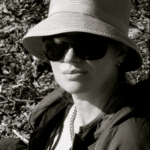Step 3: "staystitch from each shoulder toward center". For front yoke? Really?
-
14 years ago LINK
Lori @Lori
It’s been ~20 years since I took home-ec in junior high, the only other time I’ve sewn clothes. My teacher Mrs Bauman’s nowhere in sight so I turn to you for help, lovely forum people 🙂
Step 3 of the Music Box Jumper instructs (and offers a supporting drawing):
“Staystitch the neckline of the outside front-yoke and the two outside back-yoke pieces…sewing from each shoulder toward the center.”
It’s the “each shoulder” part that’s causing my confusion.
It is clear how this can be done on the back-yokes (these being ‘half-pieces’ of the front yoke, I’ll start at the one shoulder, follow the curve along, and finish in the place that on these pattern pieces will end up being at the center of the back). But on the FRONT-YOKE, how on Earth can I staystitch from each shoulder and end at the center?
If I didn’t have these words, or the drawing with the arrows and was given only ‘staystitch’ as the title or task for this step, I would simply start at one shoulder, sew allllll the way ’round the curve (passing alongside the lowest point, adjacent to where a notch is), continue onward and end at the opposite shoulder. Yet the drawing clearly indicate two arrows starting at the shoulders and converging at the center (thereby supporting the written instructions to start at “each shoulder”).
Hmm… My thought process:
– Am I really meant to sew two seams that meet in the middle, near that central notch?
– How could this be better than going from one shoulder to the opposite shoulder?
– Perhaps the “each shoulder” refers to back-yoke only?
Help!
And, relatedly:
In whichever direction I go in with this staystitching business: do I need to reinforce (forward-reverse-forward) at the start and finish of these seams (ie to help the staystitches themselves stay put?)?
Thank you, in advance, for helping me venture from 2-D sewing (quilts) to 3-D (this darling jumper). I’m determined!
-Lori
14 years ago LINK Nicole
@motherof5
Nicole
@motherof5
Do it as the pattern shows,it does make a difference to the sit of the collar and/or neckline.
It is quick to do and well worth doing
Don’t reverse,its not necessary.
This step is invaluable when sewing fine fabric.
Good luck!
14 years ago LINKLori @Lori
Thanks for replying, motherof5 (wow, bet you’re busy!) but still unclear!
So, I’ll sew two seams?, each one starting on one shoulder?, and end each seam (without reversing) as close to the same place as I can possibly get (just below the central notch, at the lowest point of the front neckline)?
Do I have this right?
(happy to “do as pattern shows” but words seem to instruct two seams but illustration seems to show one continuous seam…)
14 years ago LINKJan M @Jan M
Staystitching reinforces curved areas of a garment to help prevent stretching out of shape, since they are cut on the bias. Stitching from each shoulder, toward the center, will insure the original curve of the neckline is kept. Directional stitching is important when constructing garments. You might not notice it initially, but the original curve could be lost when you start at one shoulder and stitch all the way around. On some finished garments, you may notice one side of a collar flipping up, or one side of a neckline fitting differently. Directional stitching helps to prevent that.
I usually staystitch just inside the actual seamline, so the staystitching will not be seen when that seam is stitched. You do not need to backstitch or secure the stitching at the beginning or end of the staystitching.
14 years ago LINK Tamara
@justsewit
Tamara
@justsewit
Lori, I know it is confusing but at the end you do get a better result – this is from someone who has been sewing for quite a while and has realised after some years of not stay stitching anything!
Education does young sewists a disservice you know – I wasn’t allowed to learn to thread an overlocker and didn’t learn half as much about sewing from the teacher as I did after I left school and continued on my own. Only a term of sewing at school and wasn’t even taught to sew on a button!! Incrdedible how much you learn by picking it up and reading information yourself – oh and the handy tips from others who have tried and tested with great results.
Hope the project turns out awesome and does you proud with your efforts!
14 years ago LINK Nicole
@motherof5
Nicole
@motherof5
Hi Lori,sorry not to be clearer.
Thats right,I use a bigger stitch length as it will not be visible.
Any prob’s buzz back here!
xn
14 years ago LINK Violaisabelle
@Violaisabelle
Violaisabelle
@Violaisabelle
Hi Lori,
Let me see if I can help you. In step three, what you are doing is taking the ‘single layers’ of the front yoke pieces (also known as the fashion fabric side) and stay stitching them *before* you sew any seams. You stay stitch, just as the arrows show you in the diagram. You go from the outer shoulder to the center neckline, flip the piece and do it from the other shoulder to the center front. This helps to control the ‘stretch’ of the fabric while handling and assembling the garments, as well as once the garments is sewn together. It’s a step a lot of people like to skip, but don’t. 😉
Once you have staystiched those pieces, you will then stitch the shoulders of the yoke (fashion fabric) pieces together. The direction then tell you to stitch the shoulders together of the yoke-facing pieces or ‘lining’ pieces. Liesl does not not direct you to stay stitch the yoke-facing pieces (lining), but I chose to do that, simply because of handling the pieces can cause stretching before I get the yoke and lining pieces stitched together.
You do not lockstiched or reverse stitching at the beginning and end of stay stitching, but you do for sewing the seams together, both at the beginning and the end of stitching those seams.
Remember to keep you stay stitching at the 3/8″ line and your seam at the 1/2″ stitching line. 🙂
I hope that’s helpful.
Carol
14 years ago LINK Violaisabelle
@Violaisabelle
Violaisabelle
@Violaisabelle
Oops, I guess we must have all been typing at the same time. 🙂 Hopefully Lori has enough information now. 🙂
Carol
14 years ago LINKLori @Lori
Oh, you lovely people who are so generous with your time and knowledge! I’m a bit of an “information lover” so all of this is just fabfabfab. Your explanations resonate with the educator side of me and as for the learner side of me, well, I’m just downright giddy to return to my project!
Jan M: Because of you, I will never have a flipping up collar 🙂 Thanks for taking the time to explain that to me.
justsewit: I, too, think it’s a shame that fewer ‘life skills’ are being taught these days in school. I think Health & Safety gone mad is partially to blame. And learning by doing is the best way for me, too (and for many young people, too, I would argue, who in our computing-based and digital world seem to have ever fewer opportunities to MAKE and DO things with their hands. We need those spatial skills to be developed!).
motherof5: Bigger stitches on staystitching, got it. I wouldn’t have thought of that. Thanks.
Violaisabelle (Carol): You’ve taught me that when reading patterns, I should question if applying MORE or DIFFERENT techniques will help me produce a better end product. I’ll staystitch the lining pieces, as well…being mindful of my 3/8″s and 1/2″s 🙂
I’ll let you know how I get on. Today is our little village’s ‘gala’, the annual country fair. Just popping out for that. I expect lots of sewing inspiration, with the children in their best duds, amidst the cake stalls and potato sack races. Very English!
Many thanks, all.
You must be logged in to reply to this topic.
copyright
Unless otherwise credited, all work on this blog is © Liesl + Co., Inc, 2008-2026. You are welcome to link to this blog, but please ask permission before using any text or images.